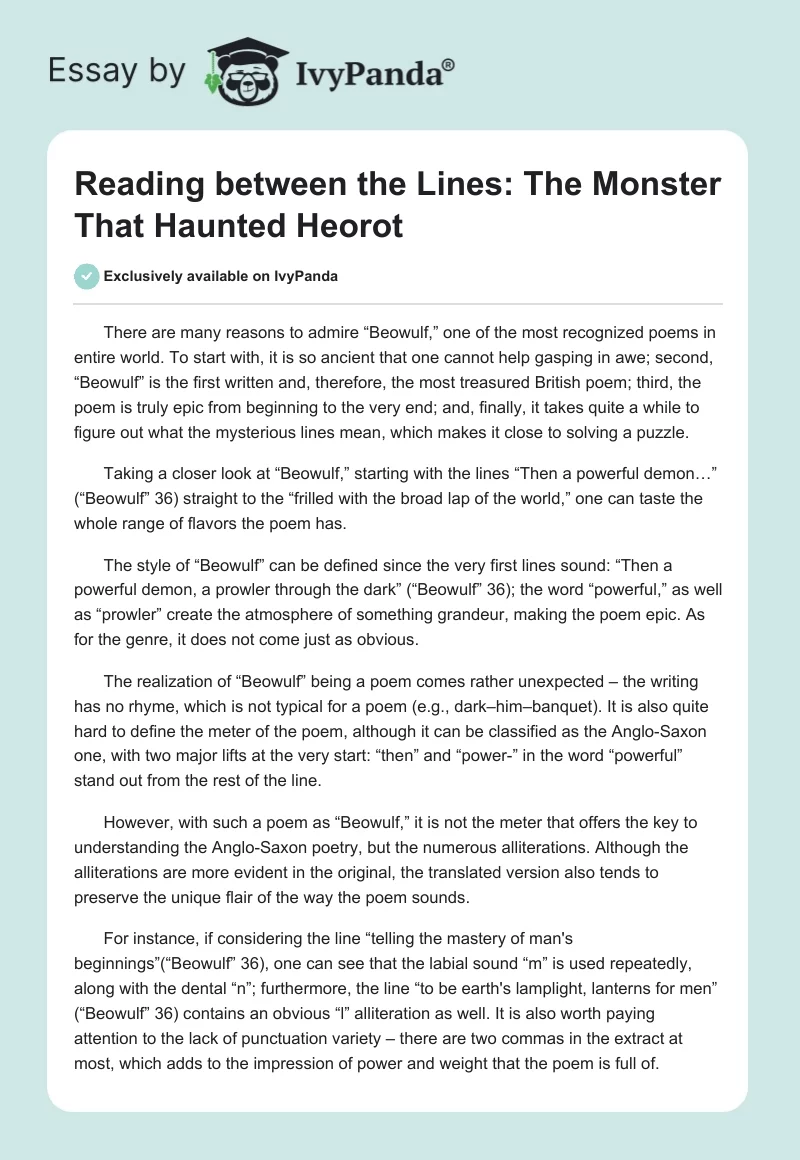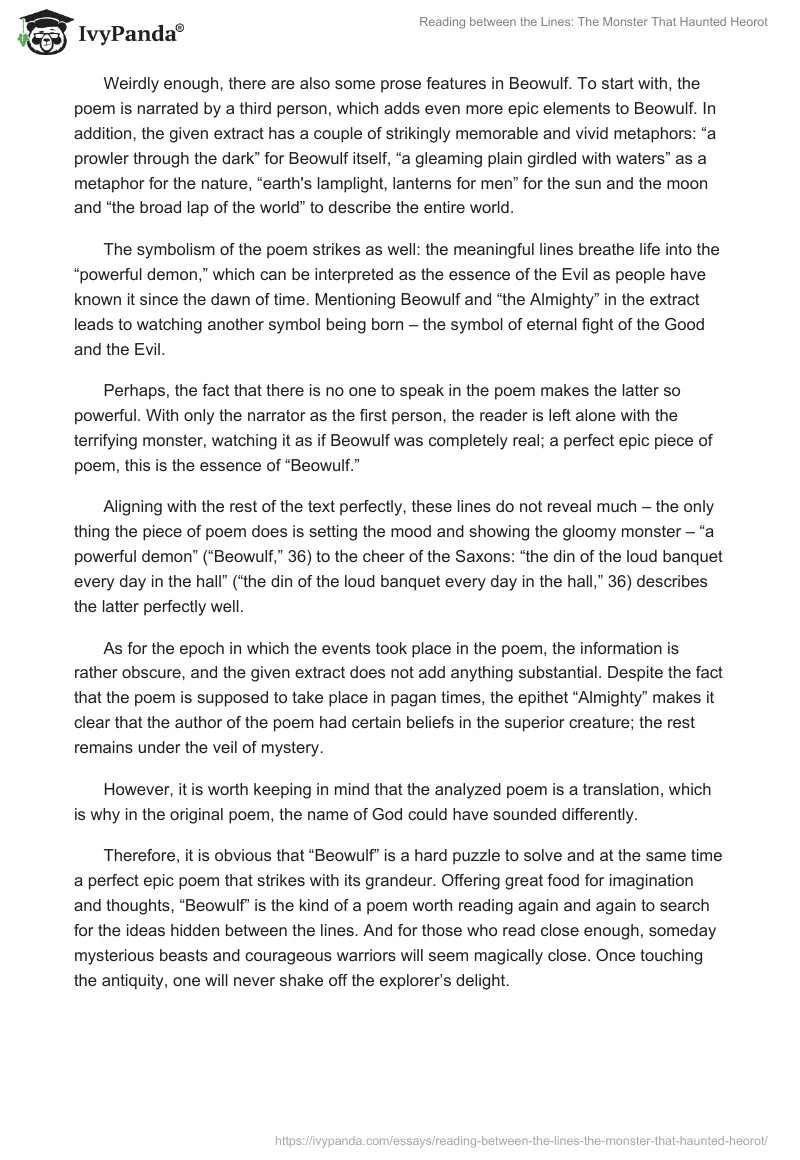There are many reasons to admire “Beowulf,” one of the most recognized poems in entire world. To start with, it is so ancient that one cannot help gasping in awe; second, “Beowulf” is the first written and, therefore, the most treasured British poem; third, the poem is truly epic from beginning to the very end; and, finally, it takes quite a while to figure out what the mysterious lines mean, which makes it close to solving a puzzle.
Taking a closer look at “Beowulf,” starting with the lines “Then a powerful demon…” (“Beowulf” 36) straight to the “frilled with the broad lap of the world,” one can taste the whole range of flavors the poem has.
The style of “Beowulf” can be defined since the very first lines sound: “Then a powerful demon, a prowler through the dark” (“Beowulf” 36); the word “powerful,” as well as “prowler” create the atmosphere of something grandeur, making the poem epic. As for the genre, it does not come just as obvious.
The realization of “Beowulf” being a poem comes rather unexpected – the writing has no rhyme, which is not typical for a poem (e.g., dark–him–banquet). It is also quite hard to define the meter of the poem, although it can be classified as the Anglo-Saxon one, with two major lifts at the very start: “then” and “power-” in the word “powerful” stand out from the rest of the line.
However, with such a poem as “Beowulf,” it is not the meter that offers the key to understanding the Anglo-Saxon poetry, but the numerous alliterations. Although the alliterations are more evident in the original, the translated version also tends to preserve the unique flair of the way the poem sounds.
For instance, if considering the line “telling the mastery of man’s beginnings”(“Beowulf” 36), one can see that the labial sound “m” is used repeatedly, along with the dental “n”; furthermore, the line “to be earth’s lamplight, lanterns for men” (“Beowulf” 36) contains an obvious “l” alliteration as well. It is also worth paying attention to the lack of punctuation variety – there are two commas in the extract at most, which adds to the impression of power and weight that the poem is full of.
Weirdly enough, there are also some prose features in Beowulf. To start with, the poem is narrated by a third person, which adds even more epic elements to Beowulf. In addition, the given extract has a couple of strikingly memorable and vivid metaphors: “a prowler through the dark” for Beowulf itself, “a gleaming plain girdled with waters” as a metaphor for the nature, “earth’s lamplight, lanterns for men” for the sun and the moon and “the broad lap of the world” to describe the entire world.
The symbolism of the poem strikes as well: the meaningful lines breathe life into the “powerful demon,” which can be interpreted as the essence of the Evil as people have known it since the dawn of time. Mentioning Beowulf and “the Almighty” in the extract leads to watching another symbol being born – the symbol of eternal fight of the Good and the Evil.
Perhaps, the fact that there is no one to speak in the poem makes the latter so powerful. With only the narrator as the first person, the reader is left alone with the terrifying monster, watching it as if Beowulf was completely real; a perfect epic piece of poem, this is the essence of “Beowulf.”
Aligning with the rest of the text perfectly, these lines do not reveal much – the only thing the piece of poem does is setting the mood and showing the gloomy monster – “a powerful demon” (“Beowulf,” 36) to the cheer of the Saxons: “the din of the loud banquet every day in the hall” (“the din of the loud banquet every day in the hall,” 36) describes the latter perfectly well.
As for the epoch in which the events took place in the poem, the information is rather obscure, and the given extract does not add anything substantial. Despite the fact that the poem is supposed to take place in pagan times, the epithet “Almighty” makes it clear that the author of the poem had certain beliefs in the superior creature; the rest remains under the veil of mystery.
However, it is worth keeping in mind that the analyzed poem is a translation, which is why in the original poem, the name of God could have sounded differently.
Therefore, it is obvious that “Beowulf” is a hard puzzle to solve and at the same time a perfect epic poem that strikes with its grandeur. Offering great food for imagination and thoughts, “Beowulf” is the kind of a poem worth reading again and again to search for the ideas hidden between the lines. And for those who read close enough, someday mysterious beasts and courageous warriors will seem magically close. Once touching the antiquity, one will never shake off the explorer’s delight.
Works Cited
“Beowulf.” The Norton Anthology of English Literature, 9th Edition. Ed. Stephen Greenblatt et al. New York City, NY: W. W. Norton Limited, 2012. 36. Print.


